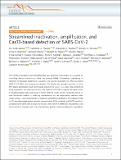Streamlined inactivation, amplification, and Cas13-based detection of SARS-CoV-2
Author(s)
Arizti-Sanz, Jon; Freije, Catherine A.; Stanton, Alexandra C.; Petros, Brittany A.; Boehm, Chloe K.; Siddiqui, Sameed; Shaw, Bennett M.; Adams, Gordon; Kosoko-Thoroddsen, Tinna-Solveig F.; Kemball, Molly E.; Uwanibe, Jessica N.; Ajogbasile, Fehintola V.; Eromon, Philomena E.; Gross, Robin; Wronka, Loni; Caviness, Katie; Hensley, Lisa E.; Bergman, Nicholas H.; MacInnis, Bronwyn L.; Happi, Christian T.; Lemieux, Jacob E.; Sabeti, Pardis C.; Myhrvold, Cameron; ... Show more Show less
DownloadPublished version (1016.Kb)
Publisher with Creative Commons License
Publisher with Creative Commons License
Creative Commons Attribution
Terms of use
Metadata
Show full item recordAbstract
The COVID-19 pandemic has highlighted that new diagnostic technologies are essential for controlling disease transmission. Here, we develop SHINE (Streamlined Highlighting of Infections to Navigate Epidemics), a sensitive and specific diagnostic tool that can detect SARS-CoV-2 RNA from unextracted samples. We identify the optimal conditions to allow RPA-based amplification and Cas13-based detection to occur in a single step, simplifying assay preparation and reducing run-time. We improve HUDSON to rapidly inactivate viruses in nasopharyngeal swabs and saliva in 10 min. SHINE’s results can be visualized with an in-tube fluorescent readout — reducing contamination risk as amplification reaction tubes remain sealed — and interpreted by a companion smartphone application. We validate SHINE on 50 nasopharyngeal patient samples, demonstrating 90% sensitivity and 100% specificity compared to RT-qPCR with a sample-to-answer time of 50 min. SHINE has the potential to be used outside of hospitals and clinical laboratories, greatly enhancing diagnostic capabilities.
Date issued
2020-11Department
Harvard University--MIT Division of Health Sciences and TechnologyJournal
Nature Communications
Publisher
Springer Science and Business Media LLC
Citation
Arizti-Sanz, Jon et al. "Streamlined inactivation, amplification, and Cas13-based detection of SARS-CoV-2." Nature Communications 11, 1 (November 2020): 5921 © 2020 The Author(s)
Version: Final published version
ISSN
2041-1723